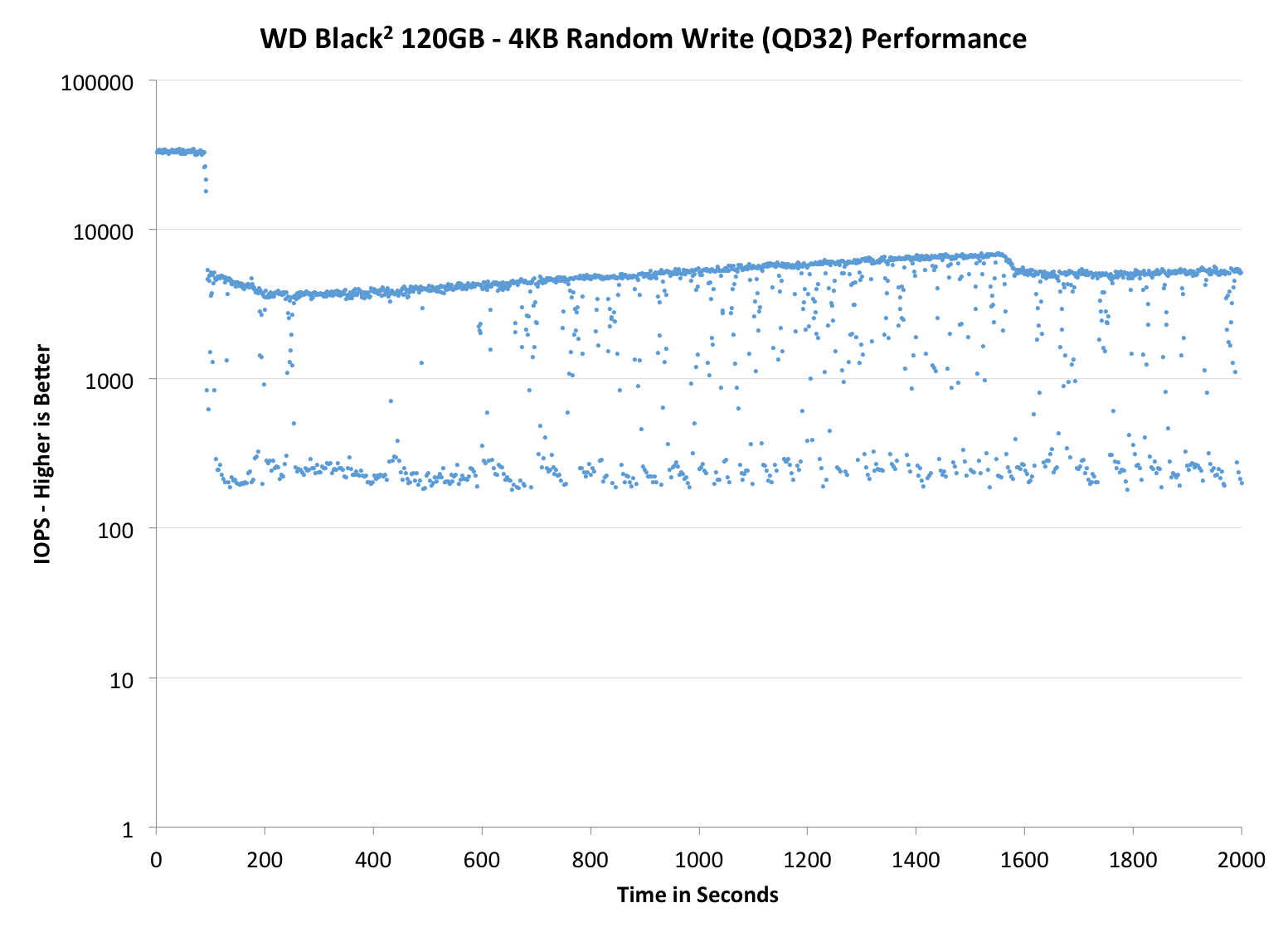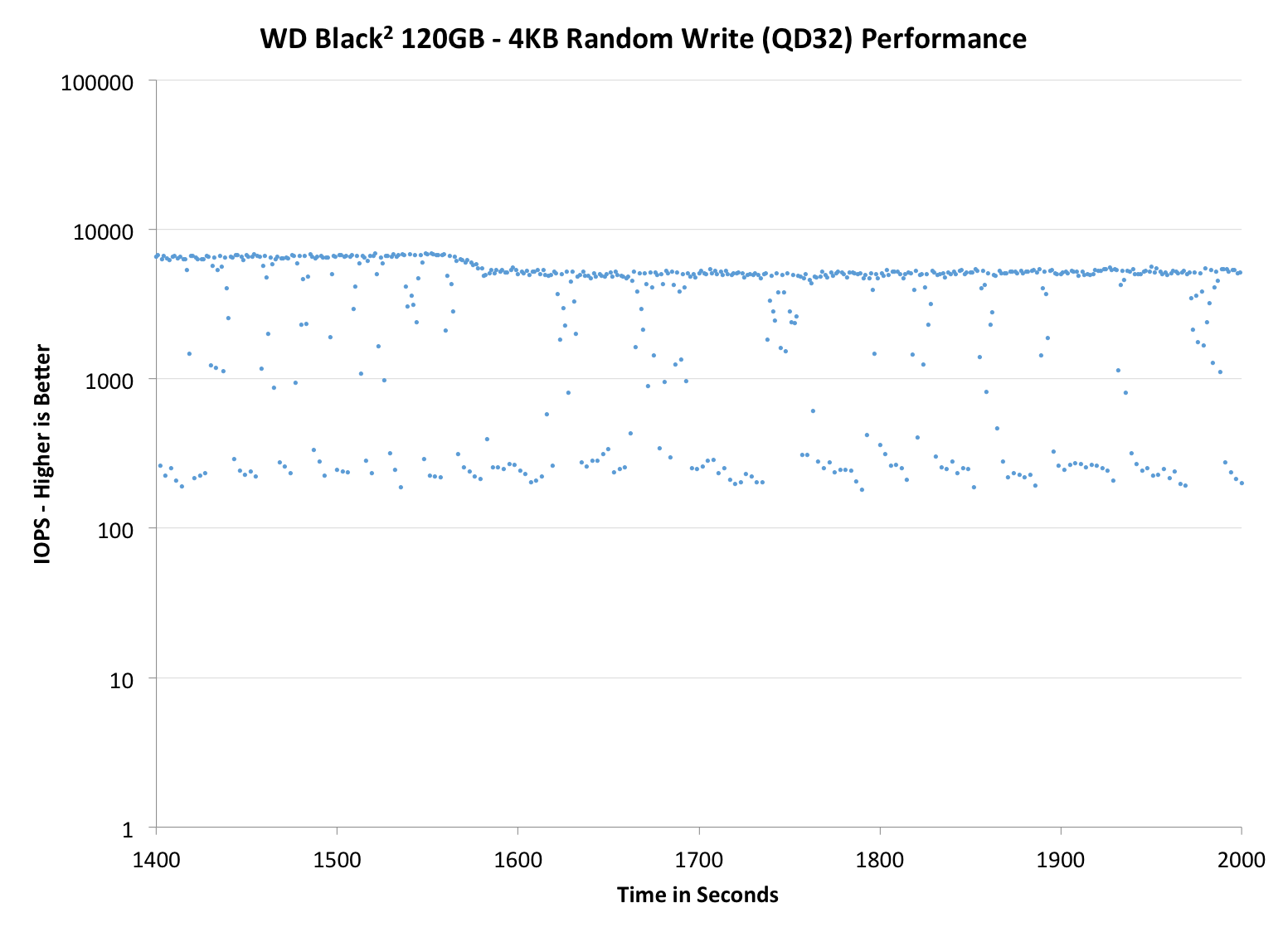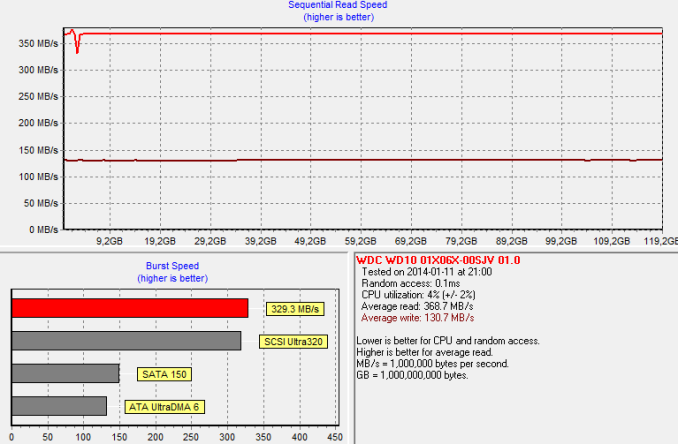The WD Black2 Review: World's First 2.5" Dual-Drive
by Kristian Vättö on January 30, 2014 7:00 AM ESTPerformance Consistency
Performance consistency tells us a lot about the architecture of these SSDs and how they handle internal defragmentation. The reason we don’t have consistent IO latency with SSD is because inevitably all controllers have to do some amount of defragmentation or garbage collection in order to continue operating at high speeds. When and how an SSD decides to run its defrag or cleanup routines directly impacts the user experience as inconsistent performance results in application slowdowns.
To test IO consistency, we fill a secure erased SSD with sequential data to ensure that all user accessible LBAs have data associated with them. Next we kick off a 4KB random write workload across all LBAs at a queue depth of 32 using incompressible data. The test is run for just over half an hour and we record instantaneous IOPS every second.
We are also testing drives with added over-provisioning by limiting the LBA range. This gives us a look into the drive’s behavior with varying levels of empty space, which is frankly a more realistic approach for client workloads.
Each of the three graphs has its own purpose. The first one is of the whole duration of the test in log scale. The second and third one zoom into the beginning of steady-state operation (t=1400s) but on different scales: the second one uses log scale for easy comparison whereas the third one uses linear scale for better visualization of differences between drives. Click the buttons below each graph to switch the source data.
For more detailed description of the test and why performance consistency matters, read our original Intel SSD DC S3700 article.
 |
|||||||||
| WD Black2 120GB | Samsung SSD 840 EVO mSATA 1TB | Mushkin Atlas 240GB | Intel SSD 525 | Plextor M5M | |||||
| Default | |||||||||
| 25% OP | - | ||||||||
The area where low cost designs usually fall behind is performance consistency and the JMF667H in the Black2 is no exception. I was actually expecting far worse results, although the JMF667H is certainly one of the worst SATA 6Gbps controllers we've tested lately. The biggest issue is the inability to sustain performance because while the thickest line is at ~5,000 IOPS, the performance is constantly dropping below 1,000 IOPS and even to zero on occasion. Increasing the over-provisioning helps a bit, although no amount of over-provisioning can fix a design issue this deep.
 |
|||||||||
| WD Black2 120GB | Samsung SSD 840 EVO mSATA 1TB | Mushkin Atlas 240GB | Intel SSD 525 | Plextor M5M | |||||
| Default | |||||||||
| 25% OP | - | ||||||||
 |
|||||||||
| WD Black2 120GB | Samsung SSD 840 EVO mSATA 1TB | Mushkin Atlas 480GB | Intel SSD 525 | Plextor M5M | |||||
| Default | |||||||||
| 25% OP | - | ||||||||
TRIM Validation
To test TRIM, I first filled all user-accessible LBAs with sequential data and continued with torturing the drive with 4KB random writes (100% LBA, QD=32) for 30 minutes. After the torture I TRIM'ed the drive (quick format in Windows 7/8) and ran HD Tach to make sure TRIM is functional.
Based on our sequential Iometer write test, the write performance should be around 150MB/s after secure erase. It seems that TRIM doesn't work perfectly but performance would likely further recover after some idle time.











100 Comments
View All Comments
Crocodile2014 - Wednesday, February 5, 2014 - link
The Seagate Hybrid Drive could have been epic... it could have taken the market by storm... but it didn't. WHY? Because they overpriced the thing out of the market.A 500Gb Seagate Hybrid drive should have been priced very similar to a 500Gb Hard Drive + 8Gb of NAND. Instead we got a device priced at the level of a 500Gb Drive with a 30Gb SSD. Why did they do this?
I get you pay a "performance premium" but when the alternatives for better performance are cheaper, you've really missed the mark.
I suspect this drive by WD will also be a fail except for OEM's wanting a smaller package for their ultrabooks also based on the price.
SDKat - Friday, February 7, 2014 - link
Amazon has a best price of almost $300 for a 1TB HD with 120 gb SSD.FAR cheaper (by about half) to buy a 1 TB HD and separate SSD. AND more versatile too!
coder111 - Friday, February 7, 2014 - link
On scale of 1 to 10, how useless is this drive on Linux? If it needs special drivers to work properly, are these drivers available in Linux? Since which kernel version? Are they open-source or a buggy binary blob?If it works with Linux, does it show up as 2 separate drives, or as 1 combined accelerated drive? If it's 1 combined accelerated drive, how does the performance compare to having dedicated SSD + dedicated hard drive combined using Linux BCache or dm-cache?
ivan256 - Wednesday, February 12, 2014 - link
The Momentus XT is the least reliable hard drive I have ever experienced. The various iterations of it haven't improved on the situation much. I have seen failure rates of more than 50% in 18 months out of a sample size of hundreds of drives.The NAND wears out way sooner than it should. Failure isn't catastrophic, because there is a copy on the rotating media, but the NAND access failures slow the drive down to a more pathetic level than you would expect even from the slow legacy portion of the disk.
They need to get the reliability up to be taken seriously. And then they need to pair the tiny amount of flash with a much faster disk.
Haravikk - Monday, March 3, 2014 - link
I just don't get the point of these drives at all; okay, so putting the two drives into one bundle is neat, but the fact that you need software to actually run it is just bewildering. Why not include hardware on the disk to manage the split between SSD and HDD, and just let users configure that as either a SATA multiplier (two disk) or a hybrid disk as desired? Shipping it as a hybrid as standard would not only make it compatible with Linux and Mac computers too, but also make things so much easier.Instead you're getting two, not every good, individual disks in a single package. I mean, 350mb/sec sequential read is decent, but hardly amazing, plus that's competing with traffic going to the HDD at the same time.
It just seems a very messy way to produce a product that I'm not sure many people really need. I'd personally rather go with a (much cheaper) hybrid drive, assuming one 2.5" drive is all I can fit. While 8gb flash gives far from the hybrid SSD performance advertised, it's just so much simpler to setup and manage (no juggling of separate volumes) and works pretty well in real-world use.
A shame, I got really excited thinking WD were making a hybrid with 128gb of flash, i.e - something that would actually be really useful.
danwat1234 - Sunday, January 25, 2015 - link
I don't think the SATA protocol allows for more than 1 drive per channel. So, the drive couldn't have been designed to act as 2 separate drives to the controller.BDProductions - Thursday, May 1, 2014 - link
I have to wonder at the author's comment about his photos..WTF do you need a DSLR for to take great images?
Ever hear of a scanner?
- Set item on glass, cover with black velour, scan, instantly AWESOME images. (you may choose another solid color to cover the item, or even turn out the lights instead when you scan)
Some scanners do better than others for material not touching the glass, but most look better than the pictures in this article...
I have a question nobody seems to address... WHY IS THERE A MANDATORY DOWNLOAD instead of just putting the drivers on the USB thumbdrive? That makes no sense, other than to FORCE you to register the drive with WD.
That will keep me from buying such a product.
How stupid is it to make such an artificial requirement when a person might want to install the drive in a remote location where not even a cellular data connection would work? Just because anyone reading this has no such worry does not validate their theory that everyone these days MUST have an internet connection where ever they are... that just isn't true.
Some users may have remote locations with little more than power, and still NEED a replacement drive with the Black2's functionality for performance reasons.
Anyway, who has installed one and been able to save the "drivers" downloaded from WD at install time?
If you can save them, how big is the package, and why would it not make sense to have included the driver on the thumbdrive instead of a forced download?
Thanks,
Eric
bungle2000 - Tuesday, December 9, 2014 - link
Has there ever been a review of the Toshiba (500Gb/8Gb) Hybrid HDD SSD Drives on AnandTech?danwat1234 - Sunday, January 25, 2015 - link
It's down to $130 on Amazon/Newegg/Ebay! Now it's a great buy. Wish it had a 7200RPM drive thoughAseries - Friday, February 20, 2015 - link
I have two HP gaming laptops that have a mSATA slot with a 32 GB micro SSD installed running Raid 0 with the a 7200 RPM drive using Intel Rapidstore driver. Two years ago it was a reasonable solution. Laptop #1 has two 7200 RPM 1 TB drives in the two drive bays available. Today I would use a 240 GB SSD drive paired with the largest available 2.5 inch 5400 RPM drive. Laptop #2 has only one drive bay. Without the mSATA option I would definitely consider the WD solution.